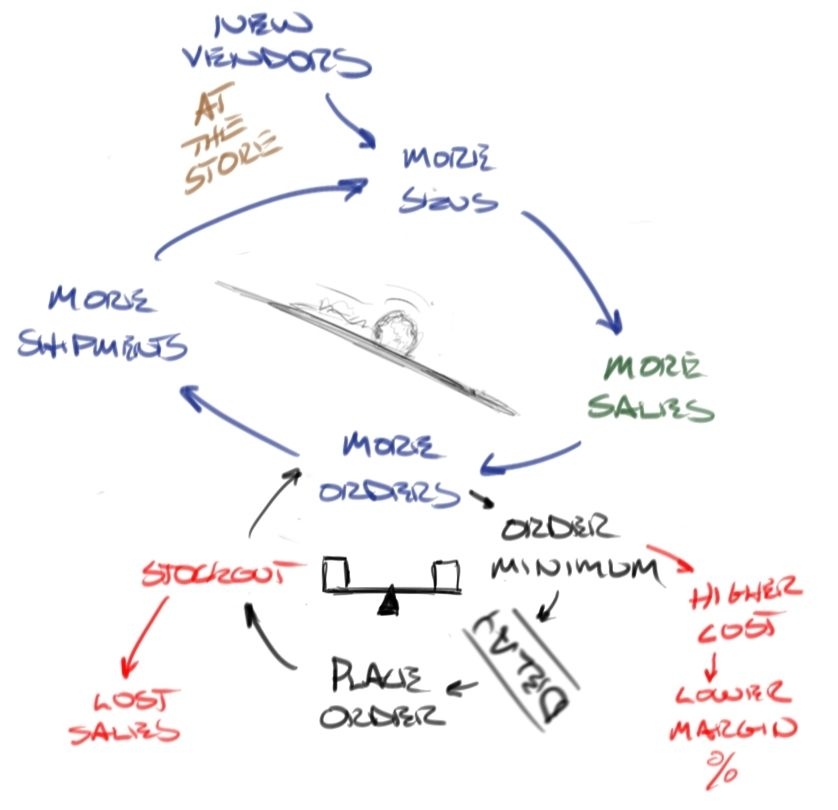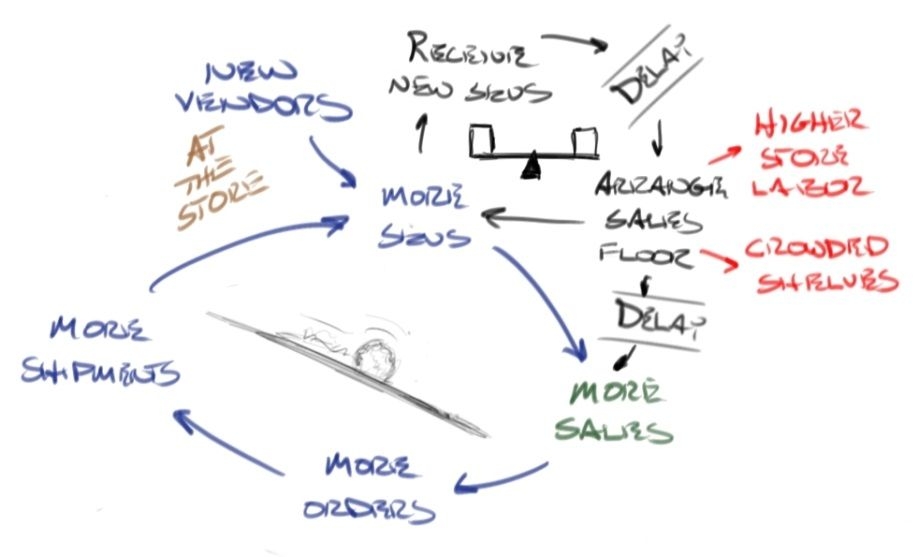Receiving Part 7
Before I left the store, I talked to the department managers in Tools and Paints. If I wanted to get the whole story, I needed to talk to these people.

In the stores, the receiving staff unloaded the product and received the goods into the book inventory. The physical movement of the product out of receiving and onto the floor was the responsibility of the merchandise department teams. Those teams did a whole lot of things beyond selling product to customers, including stocking the shelves, managing the back stock, and taking inventory by vendor to create replenishment orders. At this stage of company systems development, the department managers depended on paper forms and a sales-by-item report to figure out their vendor orders.
Vendor direct orders were associated with a number of complications. In every case, the vendor agreement required a minimum quantity for an order. In most cases, the required minimum had to do with free shipping; order less than the minimum and the vendor added shipping costs to the invoice. Some vendors had low minimums, and some had high minimums. In some cases, the vendor did not even accept an order unless it met the minimum. The total cost of the order established the minimum order. It was easier to meet a $1,000 minimum than it was to meet a $5,000 minimum.
Item minimums and multiples complicated the ordering process. All vendors required a minimum and multiple per line item. You could not order just one piece; you had to order at least one case, and in multiples of case quantity. This was not a problem for items that had strong movement; it was more problematic when the item was not a big seller.
New vendors further complicated the issue. Some of the additional lines duplicated items in the assortment, giving the customers more selection, but diluting movement for the core items. The category merchandise managers moved to a good-better-best philosophy in some categories, with the better and the best versions of a product sourced from different vendors. This philosophy increased revenue and increased gross margin dollars, but it also complicated the inventory management effort and increased the working capital required.
Painted Into the Corner
The Paint Department manager shared one example with me. We always carried the good line from our core supplier, and still carried it. Before the new program, we also bought better brushes from the core supplier. The new program dropped the better product from our core supplier, replacing it with a brush line from another supplier. The new program also added a best version from a third supplier.
The old brush program used 16 feet of aisle space to display all the various brushes, rollers, and pads from the core supplier. The new program grew the aisle to 24 feet of gondola, and an additional eight feet of display space. And brushes were not the only change in the program. The Paint Department manager told me that with all of the changes, she had to create almost 32 feet of display space without adding any additional aisles. To make that space, she reduced the depth of paint stock she maintained on the sales floor, reducing all paint SKUs to a single facing of four one-gallon cans per SKU, moving the rest of the back stock to the storage area behind the receiving area. The manager told me that all the rework took over 100 labor hours to fit more than 500 new items into the assortment.
This is why I saw so much paint in the back stockroom. While I did see some sundries, like brushes, sandpaper, and buckets, most of what I saw in the back room was pallets of paint. The manager said that the team had not had the chance to arrange the back stock room, a mission she wanted to complete, but just could not get the personnel or time to accomplish. With less depth of product on the floor, her staff started having to pull paint from backroom storage throughout the day as they mixed paint for customers. The team started every day fully stocking the aisle, something that the manager wanted the end-of-day crew to start doing. The second-shift crew did not like to stock shelves. They simply faced the product forward so it looked like product was in stock.
The Paint Department manager lamented how busy her staff had become pulling paint from the back to mix for customers, which meant that they had less time to spend with each customer. Time spent getting paint from the back room took time away from mixing more paint for customers, or helping customers select the right paint sundries. The manager did not know if total paint sales had increased or not, and she could not tell from the sales reports. She worried that sales would go down because her team could not provide the level of service that customers had come to expect.
This was not her only frustration. She came in early to do her brush reorder, following the same schedule she had always followed. “I typically can order brushes and rollers every two weeks,” she said. “This week I don’t have enough to make minimum unless I order up.”
A handful of SKUs in each of the lines sold well, while the other SKUs sold few or no additional units. The new better and best brushes sold well, but not well enough to make a minimum order. The manager looked at the order planning report with disgust. “The minimum order for each of these two vendors is $1,500. Our initial stock plan for each of the vendors is only $2,500 in inventory value, and that is what fits on the floor. The minimum order limit is 60 percent of my planned inventory for the vendors. I am going to have to order heavy, much more than what I need, just to keep in stock.” The manager had to figure out what SKUs would be the high sellers in the line and order extra to ensure a good in-stock position.
“Worse, now I don’t have enough sales in the core line to order every other week,” she said. Before the change in program, the store turned over $3,500 at cost in the brush line, making it easy to meet the $5,000 order minimum. Sales volume was up to $4,200 per week, but now spread over three different vendors, each with different minimums and order requirements. The new better–best lines cannibalized the core product line enough that sales in that line dropped to about $2,200 per week. “It is too early to tell if the core vendor’s sales will remain the same,” she said. “I am going to bump up my stock levels in the core lines too, so I can maintain an every-other-week cycle.”
I felt sorry for the Paint Department manager as I headed over to the tool department. I could feel the stress in her voice as she told me about the changes. She was worried that sales would go down because her team was spending more time on restocking shelves and not directly serving customers. I knew she was worried about how much inventory she would have to carry, since department inventory dollars was a key metric the store group used to score performance. She was just as worried about empty hooks, another measure of performance. It made sense that she would pay attention to department sales and empty hooks, since more stock supported more sales.
Two Out of Three Ain’t Bad
It sounded like the new program might be a step backwards.



